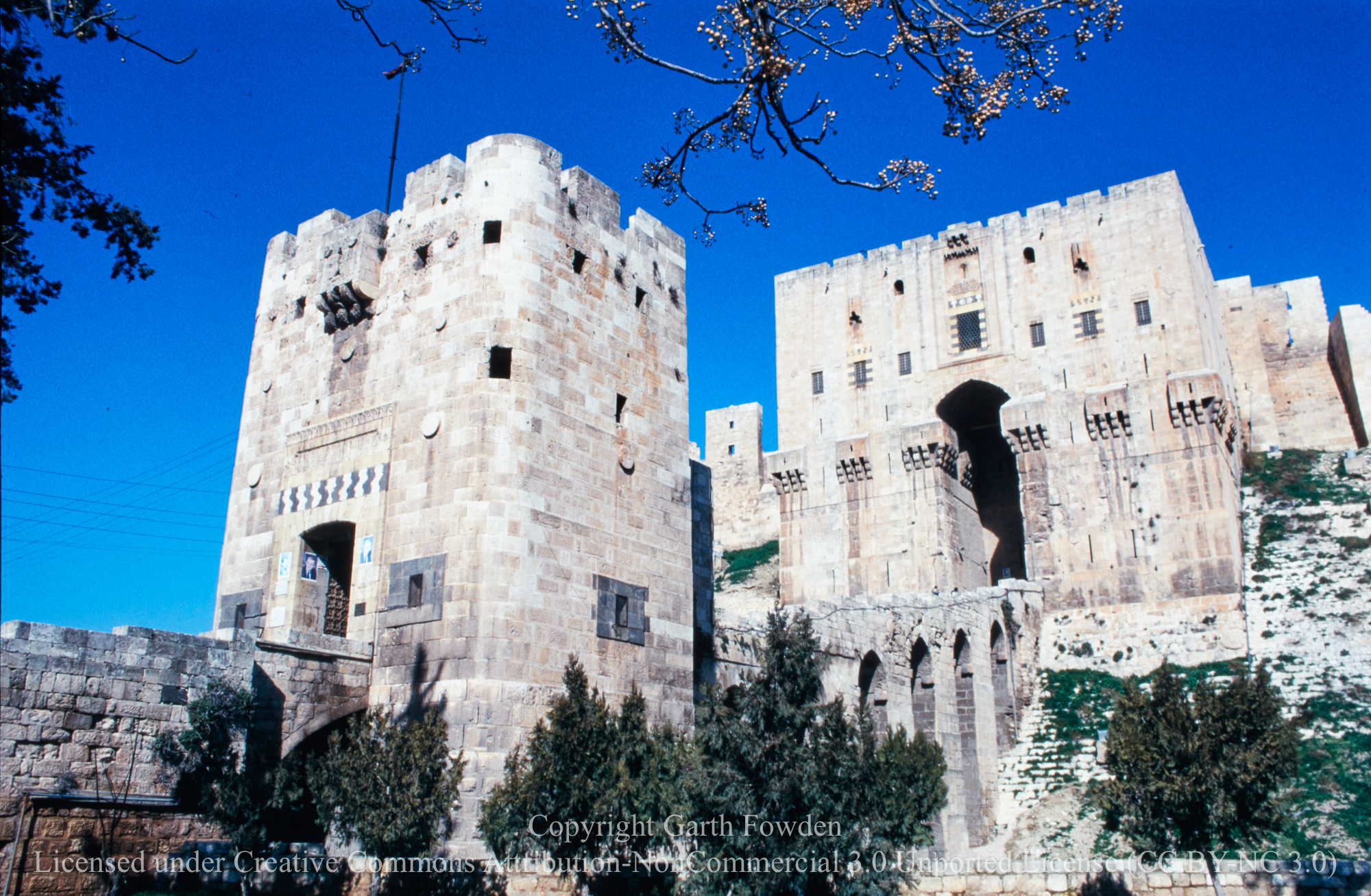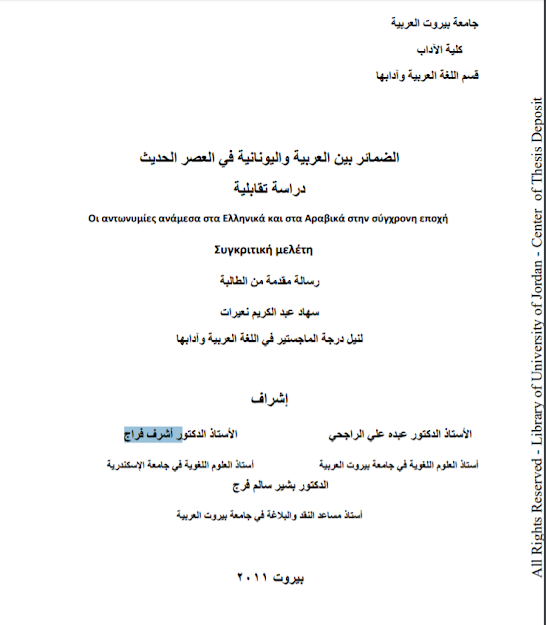Greco-Roman Legacy in Egypt
The blog aggregates news about publications, activities, etc. related to Egyptian/Arabic scholarship in the field of Greco-Roman studies and thus seeks to challenge the Eurocentrism prevalent in the field. It aims also at directing the attention to relevant materials from modern nonacademic/public contexts; roughly from 1798-to the present. The news comes mainly from Egypt without excluding other Arabic countries.
CC License
Sunday, April 6, 2025
We and they: decolonizing Graeco-Roman and Biblical antiquities – Bryn Mawr Classical Review
Saturday, March 22, 2025
نشر القطع الأثرية نشر غير علمي سواء محلياً أو دولياً
أرى أن الباحثين الذين ينشرون القطع الأثرية المصرية نشر علمى هو فى حقيقة الأمر بعيد كل البعد عن العلمية لأنه يتغاضى عن ظروف خروج هذه القطع من مصر سواء فى القرون الماضية تحت الإحتلال أو فى الوقت الحالى. كل ما يهتم به الباحثين إتباعا لنهج الباحثين الإستعماريين فى الغرب هو النص وهو أمر فيه تقليد أعمى وليس من العلمية فى شئ.
نمط معروف
Wednesday, February 12, 2025
Manufacturing Silence in Antiquity-related displines
Manufacturing silence in antiquity-related disciplines
Sunday, January 12, 2025
Unearthed, Smuggled and Decontextualized: Carl Schmidt and the Provenance of Hamburg’s Papyrus Bilinguis 1
- Online Publication Date:
- 16 Sep 2024
Abstract
Information regarding the provenance of papyrological material that was acquired in the Egyptian antiquities market in the late nineteenth and early twentieth centuries is scarce and often unreliable. This article investigates the provenance of Hamburg’s Papyrus Bilinguis 1, famed for containing the apocryphal Acta Pauli. By researching archival files documenting the acquisition and the context of the find, the papyrus is shown to have been acquired in breach of the Egyptian antiquities law of 1912. The article reveals how Carl Schmidt (1868–1938), the collector who acquired the manuscript for the Hamburg library, by concealing information, tried to cover up his own criminal involvement in the smuggling of the manuscript. Through the investigation of a manuscript that was acquired by a public German institution in awareness of its illegality, the article hopes to contribute to current debates on the translocation of cultural heritage artefacts to Europe and the US in the age of European colonialism and imperialism.
Sunday, April 23, 2023
A New Publication in Papyrology (P.Leid.Inst. II) with Minimal Details about Provenance!
Provenance Details of P.Leid.Inst. II
[Retrieved from papylist on 23/04/2023]
This volume contains the first edition of 66 papyri and ostraca in the collection of the Leiden Papyrological Institute. The texts are dated between the third century BCE and the eighth century CE and originate from Egypt. They include two Demotic literary papyri (one of which is written in Hieratic script), 19 Demotic ostraca, 44 Greek documentary papyri and one Coptic ostracon.
---
Last week a new publication of Egyptian papyri has been announced in papylist (email list of papyrologists, see experts above) with minimal details about where these artefacts were acquired.
The papyri are kept at the institute of the papyrology at Leiden University. The publication comes in a time where much of the debate, both publicly and academically, centres on the provenance issue i.e. where and when these materials left the original country.
It strikes me that the formulations at the introduction are to vague to allow for any real assessment of the legality, if any, or illegality of the material acquired by the institutes in various periods. No references to the documentations provided and no export licences added, at least in the introduction where the matter of provenance is briefly presented. What add insult to injury is the fact that the full details remain behind a paid wall of Brill. It is not open-access and therefore I don't have any access to more details on this. It would be a good idea if the Leiden institute considered the idea of sending two or three copies Egypt. Further details on this publication can be found here P.Leid.Inst. II .
Here is a screenshot of the paragraph I am refereeing to.
Tuesday, March 1, 2022
MedAfrica
Archaeological deep history and dynamics of Mediterranean Africa
ca. 9600-700BC
 |
| License free image from https://pixabay.com/illustrations/earth-planet-world-globe-1617121/ |
The project is based at the McDonald Institute for Archaeological Research, University of Cambridge, and is funded by the Leverhulme Trust.
More is to be found here MedAfrica.
Saturday, May 1, 2021
Greenhalgh, Plundered Empire : acquiring antiquities from Ottoman lands (Brill 2019)
Plundered Empire
Tuesday, April 6, 2021
Monday, April 5, 2021
Sunday, February 21, 2021
Tuesday, July 28, 2020
A Special Program in A Special City: Study in Alexandria
Monday, July 13, 2020
Database Objects from Coptos
Dear colleagues,
During several years, Vanessa Desclaux has collected information about more than 1700 objects from the site of Coptos now preserved in various museums, together with their bibliography. We are pleased to announce the publication of this database in its first version:
We hope this tool will be useful for further research.
With our best wishes,
Laure Pantalacci & Vanessa Desclaux
The Invention and Reinvention of the Egyptian Peasant
I am more inclined to accept the second guess since he was a government official, first in the village administration council and eventually int he nearby town council, and most probably had this idea from his predecessors and colleagues, before making it his own motto. Cf. Timothy Mitchell,The Invention and Reinvention of the Egyptian Peasant, International Journal of Middle East Studies, Vol. 22, No. 2 (May, 1990), p. 132-133, where he speaks of Critchfield's portrait of Shahhat, a village in Luxor near Kings' valley:
Thursday, July 9, 2020
The Digital Photographic Archive of Professor Garth Fowden FBA
Fowden's Digital Photographic Archive
Tuesday, July 7, 2020
Open Access to Classical Papers, the journal of Cairo University's Greek and Latin department
Classical Papers
Wednesday, June 17, 2020
Pronouns in Modern Greek and Arabic: A Comparative Linguistical Study, MA thesis, Beirut 2011
Οι αντωνυμίες ανάμεσα στα Ελληνικά και στα Αραβικά στην σγύχρονη εποχή Συγκριτική μελέτη
الضمائر بين العربية واليونانية فى العصر الحديث: دراسة تقابلية
Monday, August 19, 2019
"The heyday of the Prosopographia Imperii Romani is over"
Conclusion
Wednesday, August 14, 2019
Historicizing Algerian war of Independence: Jugurtha's Tragedy and Algerian Iliad
Jugurtha's Tragedy and Algerian Iliad
Tuesday, August 13, 2019
Postcolonial history of Cyrene, Libya: Chamoux's Greek Cyrène of 1953 into Arabic in 1980
Chamoux's Greek Cyrène of 1953 into Arabic in 1980
Postcolonial History of North Africa:Gsell's L'Histoire into Arabic in 2007
Gsell's L'Histoire into Arabic in 2007
Arabic dictionary and Index of the Greek New Testament
Arabic dictionary and Index of the Greek New Testament
Arabic Students of the Greek New Testament are especially grateful to the late Ghassan Khalaf (1945-2018), former ABTS President and Professor of Biblical Studies, for this magnificent contribution to Bible studies and Greek lexicography.How to encode Arabic script in the Leiden+ Epidoc XML using the papyrological editor?
For the First Time in the History of Papyrology Greek and Arabic United!
Friday, August 9, 2019
Egyptian-Arabic Scholarship in Classics and Papyrology: Invisible or Marginalized?
Egyptian-Arabic Scholarship in Classics and Papyrology: Invisible or Marginalized?
It's usually reported, not infrequently with astonishing confidence, that the Egyptian school of Greco-Roman Studies is a peripheral. Yet I wonder how this conclusion came 2 exist while its publications r not included either n L'Année philologique o n Bibligraphie Papyrologique!— Usama A. Gad (@usamaligad) November 20, 2018
Her is what I have found from L'Année philologique.
Making Arabic-Egyptian and Non-Egyptian scholarship in Classics Visible
Here is the spreadsheet. It is in Arabic, but I will transcribe the titles into English and provide every record with an English Abstract. For non-Egyptians scholarship, I will translate the title into Arabic and provide the record with an Arabic abstract. Feel free to add to this list or send me your work about Egypt to make it visible in Arabic too.
1- Arabic-Egyptian Scholarship Records
2- Arabic Translations of Greek and Latin
Seneca's Epistulae Morales ad Lucilium in Arabic
Seneca's Epistulae Morales ad Lucilium in Arabic
by Muḥammad Salīm Sālim in Humanity's Heritage, Cairo 1968
Badawi: The Spring and Fall of Greek Thought
Badawi: The Spring and Fall of Greek thought
Greek Words in Arabic and their Etymology
Greek Words in Arabic and their Etymology
A Bibliography of Arabic Scholarship in Manuscript Studies
A Bibliography of Arabic Scholarship in Manuscript Studies
Tuesday, August 6, 2019
WHEN A SENATOR VISITS EGYPT, THE STUDENTS HAVE TO PREPARE THEIR TRANSLATIONS
WHEN
A SENATOR VISITS EGYPT, THE STUDENTS HAVE TO PREPARE THEIR TRANSLATIONS
συνκλήτου ἐν μίζονι (l. μείζονι) ἀξιώματι κα[ὶ] τιμῆι
5 κείμενος τὸν ἐκ τῆς π̣ό̣(λεως) ἀνάπλουν ἕως τοῦ Ἀρσι(νοίτου) νο(μοῦ)
ἐπὶ θεωρίαν ποιούμενος μεγαλουπρεπέστερον(l. μεγαλοπρεπέστερον)
ἐγδεχθήτωι(l. ἐγδεχθήτω), καὶ φρόντισον ὡς ἐπὶ τῶν
καθηκόντων τόπων αἵ τε αὐλαὶ κατασκ̣ευα̣σ̣-
[θ]ή̣σ̣[ο]ν̣ται καὶ αἱ ἀπ̣ὸ̣ τούτων ἐγβα(τηρίαι) ε̣[ ̣]ι̣ε̣[ ̣ ̣ ̣]
10 π̣ ̣ ̣ ̣ ̣ συντελεσθήσονται καὶ αὐτῶι προσ-
ενεχ̣θ̣ήσε̣ται ἐπὶ τῆς ἐγβα(τηρίας) τὰ ὑπογεγρ(αμμένα) ξένια,
καὶ τ[ὰ] εἰς τὸν τῆς αὐλῆς καταρτισμὸν
καὶ τὸ γεινόμενον τῶι Πετεσούχωι καὶ τοῖς κροκο(δείλοις)
ψω̣μ̣ί̣ον κ̣α̣ὶ̣ τὰ πρὸς τὴν τοῦ λαβυρίνθου θέαν
15 καὶ τ̣ὰ ̣[ ̣ ̣] ̣[ ̣ ̣ σ]ταθησόμενα θύματα καὶ τῆς
θ̣υ̣σ̣ί̣[α]ς̣ ἡ̣ π̣α̣ρ̣ο̣χὴ̣ ο̣ἰ̣κ̣ο̣ν̣[όμη(?)]ται(?), τὸ δʼ ὅλον ἐ̣π̣ὶ̣ π̣ά̣ν̣[των]
τὴν μεγίστην φροντίδα ποιουμενου (l. ποιούμενος) τοῦ εὐδοκοῦν̣[τ]α̣
τὸν ἄ̣ν̣δ̣ρ̣α̣ κατασταθῆ[ναι] τὴν πᾶσαν προσενέγκαι
σπουδὴ[ν]





































